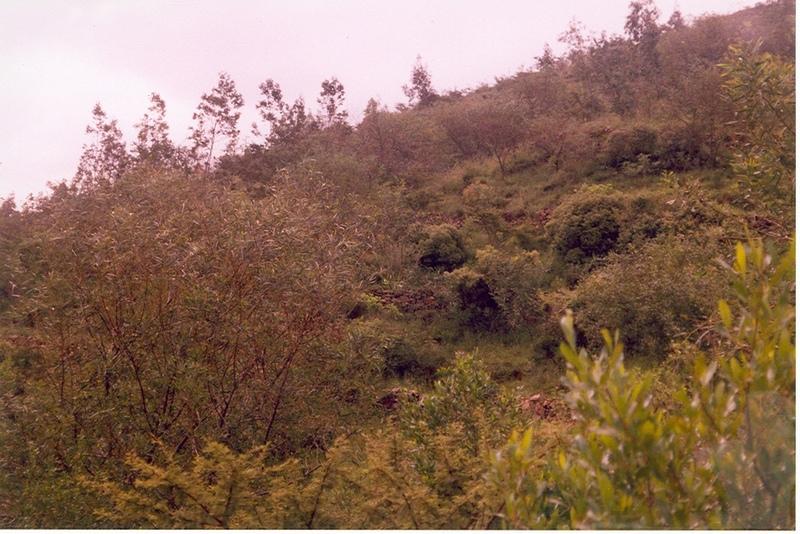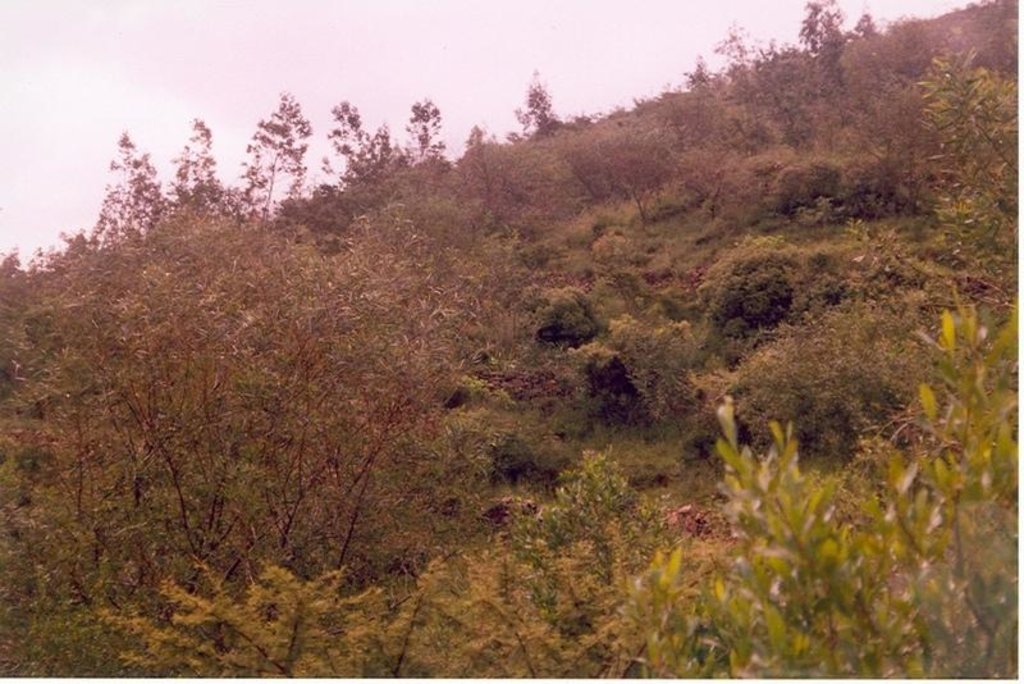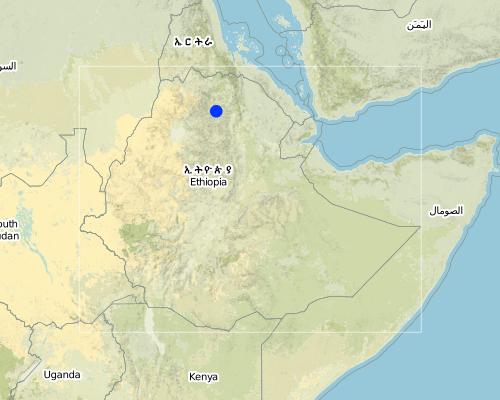Stone faced trench [Ethiopia]
- Creation:
- Update:
- Compiler: Unknown User
- Editor: –
- Reviewer: Fabian Ottiger
Emnigetsu metrebawi zala
technologies_1396 - Ethiopia
View sections
Expand all Collapse all1. General information
1.2 Contact details of resource persons and institutions involved in the assessment and documentation of the Technology
Key resource person(s)
SLM specialist:
Giday Hlefom
Ministry of Agriculture and Natural Resources
Office of agriculture and natural resources, tel 251-4-410285, Atsbi, Tigray, Ethiopia
Ethiopia
Name of the institution(s) which facilitated the documentation/ evaluation of the Technology (if relevant)
Ministry of Agriculture and Natural Resources of Ethiopia (MoA) - Ethiopia1.3 Conditions regarding the use of data documented through WOCAT
When were the data compiled (in the field)?
01/08/2003
The compiler and key resource person(s) accept the conditions regarding the use of data documented through WOCAT:
Ja
2. Description of the SLM Technology
2.1 Short description of the Technology
Definition of the Technology:
Construction of stones walls along the contour with trenches on the upper side of the structure while the upper part of the structure filled with soil and compacted.
2.2 Detailed description of the Technology
Description:
allignment of the soil along the contour, diiging of foundation, trench construction, spacing tie ridge, tree planting,
Purpose of the Technology: reduce erosion, increase soil moisture, recharge ground water, decrease ground water
Establishment / maintenance activities and inputs: stone wall construction, trench digging, tree and forage planting, area closure
Natural / human environment: enhance vegetation growth, decrease desertification, increase biodiversity
2.3 Photos of the Technology
2.5 Country/ region/ locations where the Technology has been applied and which are covered by this assessment
Country:
Ethiopia
Region/ State/ Province:
Tigray
Further specification of location:
Atsbi Womberta
Map
×2.6 Date of implementation
If precise year is not known, indicate approximate date:
- more than 50 years ago (traditional)
2.7 Introduction of the Technology
Specify how the Technology was introduced:
- through projects/ external interventions
Comments (type of project, etc.):
From outside the country
3. Classification of the SLM Technology
3.1 Main purpose(s) of the Technology
- reduce, prevent, restore land degradation
- preserve/ improve biodiversity
3.2 Current land use type(s) where the Technology is applied

Grazing land

Forest/ woodlands
(Semi-)natural forests/ woodlands:
- Clear felling
Products and services:
- Fuelwood
- Other forest products
- Nature conservation/ protection
- Cut and carry
Comments:
Major land use problems (compiler’s opinion): deforestation, soil erosion and overgrazing
Major land use problems (land users’ perception): shortage of fuel wood, shortage of food, shortage of drinking water, soil erosion
Clear felling of (semi-)natural forests: illegal cutting of trees
Plantation forestry: Yes
3.3 Further information about land use
Number of growing seasons per year:
- 1
Specify:
Longest growing period in days: 180 Longest growing period from month to month: Jun - Oct
3.4 SLM group to which the Technology belongs
- cross-slope measure
3.5 Spread of the Technology
Comments:
Total area covered by the SLM Technology is 20.3 m2.
in some places some of the structures spacing closer than the design requirement
3.6 SLM measures comprising the Technology
3.7 Main types of land degradation addressed by the Technology

soil erosion by water
- Wt: loss of topsoil/ surface erosion
- Wg: gully erosion/ gullying

chemical soil deterioration
- Cn: fertility decline and reduced organic matter content (not caused by erosion)

water degradation
- Ha: aridification
Comments:
Main type of degradation addressed: Wt: loss of topsoil / surface erosion
Secondary types of degradation addressed: Wg: gully erosion / gullying, Cn: fertility decline and reduced organic matter content, Ha: aridification
3.8 Prevention, reduction, or restoration of land degradation
Specify the goal of the Technology with regard to land degradation:
- reduce land degradation
Comments:
Secondary goals: prevention of land degradation, rehabilitation / reclamation of denuded land
4. Technical specifications, implementation activities, inputs, and costs
4.2 Technical specifications/ explanations of technical drawing
Technical knowledge required for field staff / advisors: moderate
Technical knowledge required for land users: moderate
Main technical functions: control of dispersed runoff: retain / trap, control of concentrated runoff: retain / trap, reduction of slope angle, reduction of slope length
Secondary technical functions: improvement of ground cover, increase of infiltration, water harvesting / increase water supply
Aligned: -contour
Vegetative material: T : trees / shrubs, G : grass
Number of plants per (ha): 2500
Vertical interval between rows / strips / blocks (m): 1
Spacing between rows / strips / blocks (m): 10
Vertical interval within rows / strips / blocks (m): 0.5
Width within rows / strips / blocks (m): 1
Slope (which determines the spacing indicated above): 25.00%
If the original slope has changed as a result of the Technology, the slope today is (see figure below): 15.00%
Gradient along the rows / strips: 0.00%
Bund/ bank: level
Vertical interval between structures (m): 1
Spacing between structures (m): 10
Depth of ditches/pits/dams (m): 0.5
Width of ditches/pits/dams (m): 0.85
Length of ditches/pits/dams (m): 5
Height of bunds/banks/others (m): 0.9
Width of bunds/banks/others (m): 1
Length of bunds/banks/others (m): 250
Slope (which determines the spacing indicated above): 25%
If the original slope has changed as a result of the Technology, the slope today is: 15%
Lateral gradient along the structure: 0%
Vegetation is used for stabilisation of structures.
Change of land use practices / intensity level: area closure
4.3 General information regarding the calculation of inputs and costs
other/ national currency (specify):
birr
Indicate exchange rate from USD to local currency (if relevant): 1 USD =:
8.0
Indicate average wage cost of hired labour per day:
0.88
4.4 Establishment activities
| Activity | Type of measure | Timing | |
|---|---|---|---|
| 1. | seedling production | Vegetative | July-June |
| 2. | pitting | Vegetative | April-May |
| 3. | planting | Vegetative | July |
| 4. | over sawing of grasses | Vegetative | July |
| 5. | survey & layout | Structural | Dec.-April |
| 6. | collection of stones | Structural | Dec.-April |
| 7. | digging foundation & trench | Structural | Dec.-April |
| 8. | construction | Structural | Jan.-April |
| 9. | site guard | Management | the whole year |
| 10. | enrichment plantation and replanting | Management | onset of rainy season |
4.5 Costs and inputs needed for establishment
| Specify input | Unit | Quantity | Costs per Unit | Total costs per input | % of costs borne by land users | |
|---|---|---|---|---|---|---|
| Labour | Labour | ha | 1.0 | 234.0 | 234.0 | 10.0 |
| Labour | Harvesting | ha | 1.0 | 45.0 | 45.0 | |
| Equipment | Tools | ha | 1.0 | 14.0 | 14.0 | 5.0 |
| Plant material | Seedlings | ha | 1.0 | 86.0 | 86.0 | |
| Total costs for establishment of the Technology | 379.0 | |||||
Comments:
Duration of establishment phase: 84 month(s)
4.6 Maintenance/ recurrent activities
| Activity | Type of measure | Timing/ frequency | |
|---|---|---|---|
| 1. | replanting | Vegetative | July /once |
| 2. | stone collection | Structural | January/once |
4.7 Costs and inputs needed for maintenance/ recurrent activities (per year)
| Specify input | Unit | Quantity | Costs per Unit | Total costs per input | % of costs borne by land users | |
|---|---|---|---|---|---|---|
| Labour | Labour | ha | 1.0 | 4.0 | 4.0 | 100.0 |
| Total costs for maintenance of the Technology | 4.0 | |||||
Comments:
Machinery/ tools: hand tools
length of structure
4.8 Most important factors affecting the costs
Describe the most determinate factors affecting the costs:
labour, slope, low survival rate of seedlings
5. Natural and human environment
5.1 Climate
Annual rainfall
- < 250 mm
- 251-500 mm
- 501-750 mm
- 751-1,000 mm
- 1,001-1,500 mm
- 1,501-2,000 mm
- 2,001-3,000 mm
- 3,001-4,000 mm
- > 4,000 mm
Specify average annual rainfall (if known), in mm:
300.00
Agro-climatic zone
- sub-humid
- semi-arid
5.2 Topography
Slopes on average:
- flat (0-2%)
- gentle (3-5%)
- moderate (6-10%)
- rolling (11-15%)
- hilly (16-30%)
- steep (31-60%)
- very steep (>60%)
Landforms:
- plateau/plains
- ridges
- mountain slopes
- hill slopes
- footslopes
- valley floors
Altitudinal zone:
- 0-100 m a.s.l.
- 101-500 m a.s.l.
- 501-1,000 m a.s.l.
- 1,001-1,500 m a.s.l.
- 1,501-2,000 m a.s.l.
- 2,001-2,500 m a.s.l.
- 2,501-3,000 m a.s.l.
- 3,001-4,000 m a.s.l.
- > 4,000 m a.s.l.
Comments and further specifications on topography:
Altitudinal zone: 1500-3000 m a.s.l.
Landforma: Also hillslopes and footslopes
Slopes on average: Also moderate and rolling
5.3 Soils
Soil depth on average:
- very shallow (0-20 cm)
- shallow (21-50 cm)
- moderately deep (51-80 cm)
- deep (81-120 cm)
- very deep (> 120 cm)
Soil texture (topsoil):
- medium (loamy, silty)
Topsoil organic matter:
- medium (1-3%)
- low (<1%)
If available, attach full soil description or specify the available information, e.g. soil type, soil PH/ acidity, Cation Exchange Capacity, nitrogen, salinity etc.
Soil texture: Medium (also fine/heavy and coarse/light)
Soil fertility is low-medium
Soil drainage/infiltration is medium
Soil water storage capacity is medium-low
5.6 Characteristics of land users applying the Technology
Market orientation of production system:
- subsistence (self-supply)
Off-farm income:
- less than 10% of all income
Relative level of wealth:
- very poor
- poor
Level of mechanization:
- manual work
- animal traction
Indicate other relevant characteristics of the land users:
Annual population growth: 3% - 4%
40% of the land users are poor and own 40% of the land.
60% of the land users are poor and own 60% of the land.
Off-farm income specification: there is no difference
5.7 Average area of land owned or leased by land users applying the Technology
- < 0.5 ha
- 0.5-1 ha
- 1-2 ha
- 2-5 ha
- 5-15 ha
- 15-50 ha
- 50-100 ha
- 100-500 ha
- 500-1,000 ha
- 1,000-10,000 ha
- > 10,000 ha
5.8 Land ownership, land use rights, and water use rights
Land ownership:
- state
6. Impacts and concluding statements
6.1 On-site impacts the Technology has shown
Socio-economic impacts
Production
crop production
fodder production
fodder quality
wood production
production area
Income and costs
farm income
Other socio-economic impacts
Honey production
Socio-cultural impacts
community institutions
SLM/ land degradation knowledge
Ecological impacts
Water cycle/ runoff
excess water drainage
Soil
soil moisture
soil cover
soil loss
Other ecological impacts
Biodiversity
Soil fertility
6.2 Off-site impacts the Technology has shown
reliable and stable stream flows in dry season
downstream flooding
downstream siltation
groundwater/ river pollution
6.4 Cost-benefit analysis
How do the benefits compare with the establishment costs (from land users’ perspective)?
Short-term returns:
positive
Long-term returns:
very positive
How do the benefits compare with the maintenance/ recurrent costs (from land users' perspective)?
Short-term returns:
slightly positive
Long-term returns:
positive
6.5 Adoption of the Technology
Of all those who have adopted the Technology, how many have did so spontaneously, i.e. without receiving any material incentives/ payments?
- 0-10%
Comments:
100% of land user families have adopted the Technology with external material support
35000 land user families have adopted the Technology with external material support
Comments on acceptance with external material support: estimates
There is no trend towards spontaneous adoption of the Technology
Comments on adoption trend: it is constructed on the hillside and it is labourous
6.7 Strengths/ advantages/ opportunities of the Technology
| Strengths/ advantages/ opportunities in the land user’s view |
|---|
| highly appreciate the construction of the trench because it enhance soil miosture and improve productivity of land and cropproduction. |
| Strengths/ advantages/ opportunities in the compiler’s or other key resource person’s view |
|---|
| it has a great contribution for the sustainability of production |
| increase the flow of streams |
| recharge and increase water table |
6.8 Weaknesses/ disadvantages/ risks of the Technology and ways of overcoming them
| Weaknesses/ disadvantages/ risks in the land user’s view | How can they be overcome? |
|---|---|
| restricts free grazing | allow cut and carry from the area closure |
| Weaknesses/ disadvantages/ risks in the compiler’s or other key resource person’s view | How can they be overcome? |
|---|---|
| it needs much labour during construction | mobilize the community |
| it takes land out of production | integrate the technology with other vegetative measures in order to increase the productivity of land including the areas ocuppied by the structure |
Links and modules
Expand all Collapse allLinks
No links
Modules
No modules




